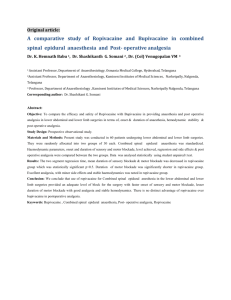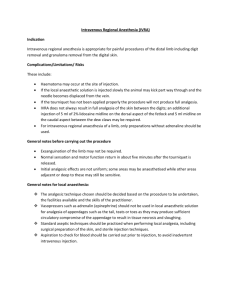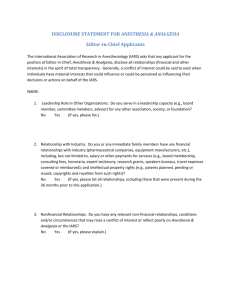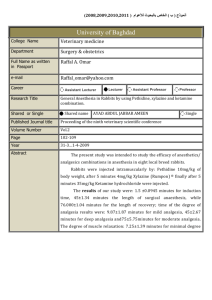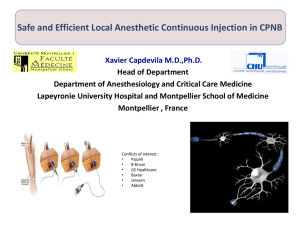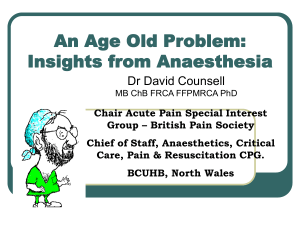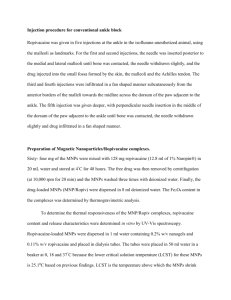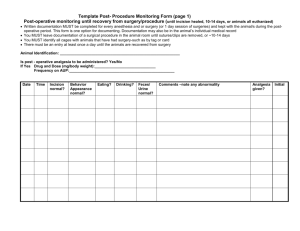efficacy of 0.2% ropivacaine and 0.5% lignocaine for bier`s block in
advertisement
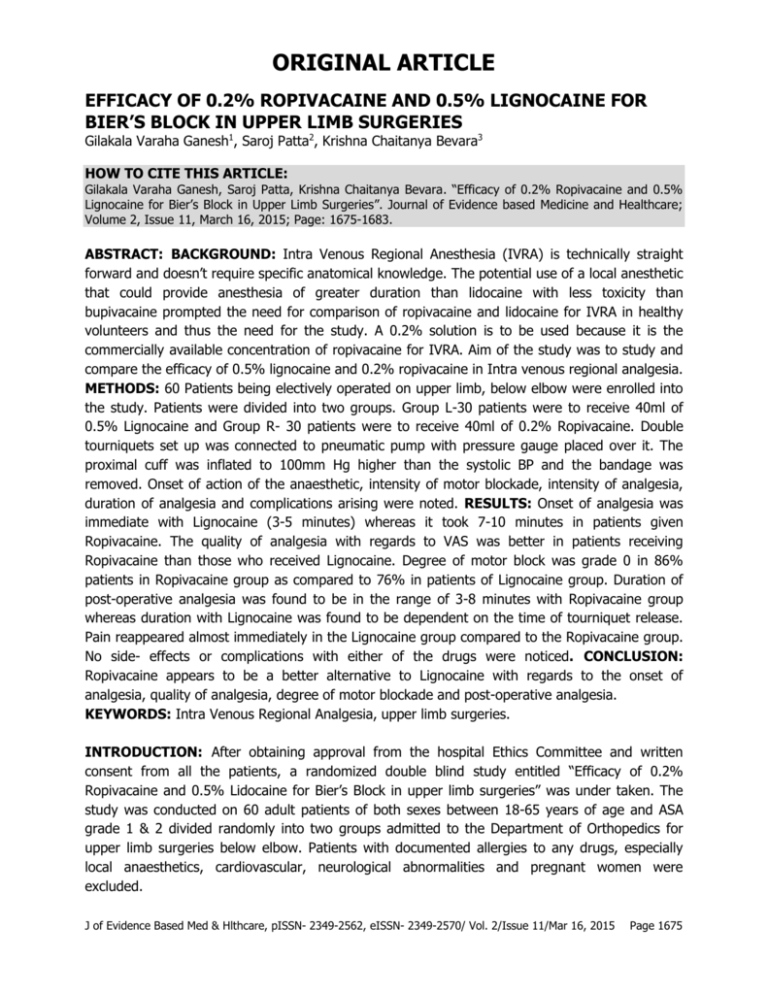
ORIGINAL ARTICLE EFFICACY OF 0.2% ROPIVACAINE AND 0.5% LIGNOCAINE FOR BIER’S BLOCK IN UPPER LIMB SURGERIES Gilakala Varaha Ganesh1, Saroj Patta2, Krishna Chaitanya Bevara3 HOW TO CITE THIS ARTICLE: Gilakala Varaha Ganesh, Saroj Patta, Krishna Chaitanya Bevara. “Efficacy of 0.2% Ropivacaine and 0.5% Lignocaine for Bier’s Block in Upper Limb Surgeries”. Journal of Evidence based Medicine and Healthcare; Volume 2, Issue 11, March 16, 2015; Page: 1675-1683. ABSTRACT: BACKGROUND: Intra Venous Regional Anesthesia (IVRA) is technically straight forward and doesn’t require specific anatomical knowledge. The potential use of a local anesthetic that could provide anesthesia of greater duration than lidocaine with less toxicity than bupivacaine prompted the need for comparison of ropivacaine and lidocaine for IVRA in healthy volunteers and thus the need for the study. A 0.2% solution is to be used because it is the commercially available concentration of ropivacaine for IVRA. Aim of the study was to study and compare the efficacy of 0.5% lignocaine and 0.2% ropivacaine in Intra venous regional analgesia. METHODS: 60 Patients being electively operated on upper limb, below elbow were enrolled into the study. Patients were divided into two groups. Group L-30 patients were to receive 40ml of 0.5% Lignocaine and Group R- 30 patients were to receive 40ml of 0.2% Ropivacaine. Double tourniquets set up was connected to pneumatic pump with pressure gauge placed over it. The proximal cuff was inflated to 100mm Hg higher than the systolic BP and the bandage was removed. Onset of action of the anaesthetic, intensity of motor blockade, intensity of analgesia, duration of analgesia and complications arising were noted. RESULTS: Onset of analgesia was immediate with Lignocaine (3-5 minutes) whereas it took 7-10 minutes in patients given Ropivacaine. The quality of analgesia with regards to VAS was better in patients receiving Ropivacaine than those who received Lignocaine. Degree of motor block was grade 0 in 86% patients in Ropivacaine group as compared to 76% in patients of Lignocaine group. Duration of post-operative analgesia was found to be in the range of 3-8 minutes with Ropivacaine group whereas duration with Lignocaine was found to be dependent on the time of tourniquet release. Pain reappeared almost immediately in the Lignocaine group compared to the Ropivacaine group. No side- effects or complications with either of the drugs were noticed. CONCLUSION: Ropivacaine appears to be a better alternative to Lignocaine with regards to the onset of analgesia, quality of analgesia, degree of motor blockade and post-operative analgesia. KEYWORDS: Intra Venous Regional Analgesia, upper limb surgeries. INTRODUCTION: After obtaining approval from the hospital Ethics Committee and written consent from all the patients, a randomized double blind study entitled “Efficacy of 0.2% Ropivacaine and 0.5% Lidocaine for Bier’s Block in upper limb surgeries” was under taken. The study was conducted on 60 adult patients of both sexes between 18-65 years of age and ASA grade 1 & 2 divided randomly into two groups admitted to the Department of Orthopedics for upper limb surgeries below elbow. Patients with documented allergies to any drugs, especially local anaesthetics, cardiovascular, neurological abnormalities and pregnant women were excluded. J of Evidence Based Med & Hlthcare, pISSN- 2349-2562, eISSN- 2349-2570/ Vol. 2/Issue 11/Mar 16, 2015 Page 1675 ORIGINAL ARTICLE Patients were divided into two groups. Group L- 30 patients were to receive 40ml of 0.5% lidocaine and Group R- 30 patients were to receive 40ml of 0.2% Ropivacaine. An 18G intra venous cannula was inserted into a vein on one of the non-operating limb for the purpose of administering fluids or drugs. CANNULATION FOR IVRA: A 22G intravenous cannula was introduced into suitable vein on dorsum of hand that was to be operated as distally as possible and firmly secured. TOURNIQUET: Cotton padding was placed on proximal part of the limb to be operated. Double tourniquets set up was connected to pneumatic pump with pressure gauge placed over it. EXANGUINATING THE EXTREMITY: The arm to be operated was elevated to 90˚ from the body above the level of heart for 5 minutes to drain the blood from the limb. A bandage was wrapped tightly around the arm from most distal part to near the pneumatic tourniquet for further exsanguination. The proximal cuff was inflated to 100mm Hg higher than the systolic blood pressure and the bandage was removed. The limb to be operated was placed horizontally and then the local anaesthetic was injected steadily by an anesthesiologist unaware of the drug he/she was administering watching for any change in the cardiovascular or respiratory status of the patient. After injecting, IV cannula was removed and pressure was applied to venepuncture site for some time till bleeding stops. As soon as the patient developed sensory and motor blockade as determined by loss of sensation to pin prick and Modified Bromage Scale respectively, the surgeon was asked to proceed with the surgery. When the proximal tourniquet pressure became unbearably painful (rated as 10 on a verbal numeric scale [VNS] where 0 = no pain and 10 = the worst pain imaginable), the distal cuff was inflated, followed by release of the proximal tourniquet. The VNS was used instead of the more commonly used visual analog scale (VAS) because the former does not require the use of a visual prompt and is considered preferable when visual and motor coordination are impaired, i. e., immediately after tourniquet deflation. It has been confirmed that although the VAS has superior ratio scale characteristics, both the VNS and VAS provide consistent measures of experimental and clinical pain intensity and can be used separately to measure pain.2,3 The distal tourniquet remained inflated until a VNS score of 10 was again reported. The following parameters were noted 1. Onset of Action of the anesthetic assessed by pin prick sensation. 2. Assessment of block: Six areas supplied by radial, median and ulnar nerves were tested in sequence. At 90 second intervals after administration, the sensory block was assessed by using a 24G needle. The patient verbally signified the sensation as pin prick, touch or absent. Cold sensation was assessed using a cube of ice placed in sterile test tubes. Motor function was assessed at 90 second interval by asking the subject to flex and extend his wrist and fingers. Complete motor block was considered when no voluntary movement was possible. J of Evidence Based Med & Hlthcare, pISSN- 2349-2562, eISSN- 2349-2570/ Vol. 2/Issue 11/Mar 16, 2015 Page 1676 ORIGINAL ARTICLE 3. Intensity of motor blockade was assessed using modified Bromage scale.4 4. Intensity of analgesia- by Visual Analogue scale.5 5. Pulse rate, blood pressure- were monitored every 3 minute for first 15 minutes, thereafter every 5minutes. 6. Tourniquet release time and monitoring after tourniquet release. 7. Duration of analgesia as per time to requirement of first analgesia after removal of tourniquet. 8. Complications arising intra and post–operatively if any. RESULTS: Fig. 1: ONSET OF ANALGESIA – DISTRIBUTION BETWEEN LIGNOCAINE AND ROPIVACAINE The mean time of onset of analgesia is depicted in the graph. There was significant difference in the time of onset of analgesia between the groups (p<0.5). The onset of analgesia was faster in the Group R than Group L. Mean of time of onset of analgesia group L-2.33+0.54 min. Mean of time of onset of analgesia Group R-7.26+1.04 minutes. Fig. 2: INTENSITY OF ANALGESIA J of Evidence Based Med & Hlthcare, pISSN- 2349-2562, eISSN- 2349-2570/ Vol. 2/Issue 11/Mar 16, 2015 Page 1677 ORIGINAL ARTICLE The intensity of analgesia (indirectly shown as grade in FACES PAIN SCALE was more in Group R than Group L. (p<0.05). Mean for Visual Analogue Scale group l- 3.40. Mean for Visual Analogue Scale group r- 1.13. The mean time of requirement of rescue analgesia is shown in this chart. It was considerable more in Group R than Group L. (p<0.05). Fig. 3: Requirement of rescue analgesia Mean time of requirement of rescue analgesia for group l (minutes) - 2.13+1.1 minutes Mean time of requirement of rescue analgesia for group r (minutes) - 5.63+1.09 minutes. Fig. 4: Distribution for degree of motor block The intensity of motor blockade (denoted as Modified Bromage Scale) is shown on this chart. The degree of motor block and hence the relaxation was more in Group R than Group L. (p<0.05). J of Evidence Based Med & Hlthcare, pISSN- 2349-2562, eISSN- 2349-2570/ Vol. 2/Issue 11/Mar 16, 2015 Page 1678 ORIGINAL ARTICLE DISCUSSION: Regional anaesthesia is becoming more popular especially with the advent of safer drugs and techniques; brachial plexus block and IVRA are two such techniques which have become more useful in the last few decades. Out of these IVRA enjoyed popularity for a fair share of time but gradually lost its charm. The ease of use and its usefulness in some conditions like: 1. Full stomach patients presenting for emergency procedures on forearm. 2. Patients with severe pulmonary disorders; have revived the use of this procedure. Since, there’s been emergence of safer and more potent local anaesthetics; an attempt has been made to compare a newer local anaesthetic which is gaining popularity and an older well known drug in this procedure. Various drugs such as tetracaine, prilocaine, mepivacaine, lignocaine and bupivacaine have been used for the procedures from time to time. Etidocaine is twice as toxic as lignocaine. Chlorprocaine can produce CNS effects and thrombophlebitis. Bupivacaine is more cardio toxic and does not provide adequate muscle relaxation. Lignocaine is a safe local anaesthetic, has moderate potency, relatively early onset of action and reasonable duration of action. Mechanisms of action: Local anaesthetic when administered intra-venously diffuses into the small veins surrounding the nerves and then into the vasa nervorum and capillary plexus of the nerves, leading to a core to mantle (centrifugal) conduction block in the nerves involved1. Local anaesthetic then diffuses into the small nerves in the skin, blocking their conduction. The tourniquet can produces ischemia, which contributes to the analgesic action of the local anaesthetic by blocking nerve conduction and motor end-plate function. 20 minutes after tourniquet application alone there will be analgesia to pinprick without the injection of any local anaesthetic. However, the speed of onset and the density of anaesthesia are greater with injection of local anaesthetic.6 No control group was made because no studies have shown that tourniquet alone can provide satisfactory analgesia. The surgeries conducted were of various types but were limited to below the elbow of either the left or right upper limbs. Patients requiring surgery on both the upper limbs or both upper and lower limbs were not included in the study because of the possibility of drug toxicity due to the large volumes of the drug that must be administered and also the duration of the surgeries. This is a major limitation with any of the regional analgesia techniques like brachial plexus blocks. Additives like alfa-2 agonists and opioids may reduce the requirement of the drug dosage and hence the possibility of systemic toxicity. More than 50% of the surgeries conducted on the patients in this study were removal of implants from the upper limb of patients in whom surgery already was done previously for fractures of both bones of the fore arm. Historically, IVRA was found to be used in emergency manipulations or surgeries in patients in whom general anaesthesia was posing risk to their lives. This study however shows the usefulness of IVRA even in elective surgeries in providing a bloodless field and comfortable operating conditions for the patient. The tourniquet can be an alternative to the pressure tourniquets the surgeons apply for creating a blood less field. J of Evidence Based Med & Hlthcare, pISSN- 2349-2562, eISSN- 2349-2570/ Vol. 2/Issue 11/Mar 16, 2015 Page 1679 ORIGINAL ARTICLE Another major limitation of the procedure was the duration of the surgery. The time the tourniquet stays around the arm cannot be extended beyond 90 minutes which is the upper most limit of the duration of tourniquet on the upper limb to prevent ischemic damage to the limb. However, the mean duration of surgery in group L was 49.7+7.8 minutes and for group R was 49.4+7.1 minutes. Thus there was no significant difference in the mean duration of surgery between the two groups (p>0. 05). The procedures were of duration less than 90 minutes. Those procedures in which the analgesia had to be extended for more than 90 minutes and had to be given supplementary analgesia for any reason were excluded from the study. Elective cases were chosen for this study because the efficacy of IVRA was already proven in emergency surgeries in the forearm and its extended uses in elective surgeries need to be further evaluated. It is further noteworthy that besides the oral diazepam, no sedation was given on the day of the surgery. This also helps the analgesia to be conducted on outpatient basis. IVRA was conducted by Edson D. Carel in 1971 in pediatric age group by B. Fitz Gerald in 1976, by R. K. Mehta et al7 in 1979, Blasier and White in 1996 and Colizza and Said in 1993. In this study only adult patients were selected because of good patient cooperation with regard to the procedure. The present study also included the people in the age group 18-60 years because most of the patients presenting for surgery were in this age group and also perfectly understood the implications of the anaesthetic procedure to give consent. Also, the people of age below 18 years might have proved difficult to obtain consent and also might not be able to tolerate the tourniquet for a reasonable time. This limitation might have been overcome by giving sufficient sedation prior to the procedure which was avoided in this study. Another reason for not including patients below 18 years was fear of toxicity by the local anaesthetic dose administered. This is also a limitation and may be attenuated by adequate dose of Benzodiazepines as pre-medication prior to the procedure in addition to that given on the previous night before sleep and decreasing the dose of local anaesthetics. In this study lignocaine was used as an anaesthetic agent for 30 cases in a concentration of 0.5% for IVRA. The recommended maximum dose was 3-5mg/kg body weight. All these doses recommended serve only as a base upon which a person using the drug in the technique should apply a sensible judgment and make appropriate adjustment. Palve H et al8 stated that maximum recommended dosage of lignocaine are frequently exceeded in clinical practice as some blocks may need more lignocaine to produce adequate anaesthesia. The maximum recommended dosage of ropivacaine is 3mg/kg. Hartmannsgruber9 and colleagues administered 40ml of ropivacaine 2mg ml−1 for IVRA in healthy volunteers without any toxic symptoms. 30 patients in this study received 40 ml of 0.2% ropivacaine. Mean time of onset of analgesia after injection of 0.2% ropivacaine was 7.26+1.04 minutes. The observation is comparable to that of Hartmannsgruber10 and T. T. Niemi (2006). The onset of action is usually said to be immediate after administering the drug in IVRA. Though onset of action of Ropivacaine appears delayed, it provides dense and comfortable block. The variation from the previous studies about ropivacaine is slight and might be subjective. Further, the time of onset of action may be hastened by premedication with sedatives like benzodiazepines and opioids or additives like alpha-2 agonists or opioids to the drugs administered. These drugs may increase even the safety profile of the administered drugs and J of Evidence Based Med & Hlthcare, pISSN- 2349-2562, eISSN- 2349-2570/ Vol. 2/Issue 11/Mar 16, 2015 Page 1680 ORIGINAL ARTICLE increase the speed of onset. No benzodiazepines were administered prior to the surgery in this study. The degree of relief of pain was assessed directly by observing the Visual analogue scale. This was done by measuring on the visual analogue Scale. In the lignocaine group, 16% patients were at scale <=2, but 84% patients were at scale>=3. However 100% patients of Ropivacaine group were at scale <=2. The faces pain scale5 was chosen to quantify the degree of comfort of the patient during the procedure and therefore the quality of analgesia provided by the drugs. The advantage of using the Faces pain scale is that it is easy to understand for the observer and an easy method to quantify the grade of analgesia. Ropivacaine provided superior patient comfort to the patient than Lignocaine and patients were able to communicate freely throughout the procedure. However the degree of analgesia in Lignocaine group was lesser. The patients were anxious because of the pressure sensation they could feel on their limb being operated and had to be convinced that they need not fear. It was stressful for both the anaesthesiologist and the patient. This limitation in lignocaine group might be overcome by not only pre-operative sedatives and additives, but also intra-operative sedation. Further studies might be required regarding the safety of using sedatives intra operatively while on IVRA as it is a well-known fact that regional anaesthesia techniques fail without adequate supplementary analgesia.11 The degree of motor blockade observed in Group L was found to be Grade 0 in 6%, grade 1-76% and grade 2-18% of patients. In group R-86% patients in grade 0 and 14% patients in Grade 1. The degree of motor blockade was greater in Ropivacaine than lignocaine and it was most comfortable for the surgeon. This provides additional advantage that finer surgeries on tendons and small bones of the palm can be done very comfortably. Previous studies showed the superiority of ropivacaine in this aspect. The duration of analgesia depends on the duration the tourniquet remains in place. However return of pain sensation and demand of rescue analgesia by the patient were taken as return of sensations and time of requirement of rescue analgesia. In group L ranged from 0-3 minutes whereas it ranged from 4-8 minutes in group R. The time to requirement of rescue analgesia was more than that of lignocaine. The results were comparable to that of findings of Aijaz Ahmad.12 It is a well-known fact that the analgesia in IVRA lasts only as long as the tourniquet is in place. However, the two drugs used in the study provided analgesia even after removal of the tourniquet. The major limitation was that the duration of post-operative analgesia was not sufficient. Further it was noticed that the patients who received lignocaine not only felt return of pain earlier than Ropivacaine group, but also felt high intensity pain demanding rescue analgesia immediately. Diclofenac 75m.g. was not adequate in few patients and they needed higher analgesics like pentazocine 30m.g. I. V immediately thus necessitating the need for increased duration of post-operative monitoring for possible chances of respiratory depression. However ropivacaine proved to be a better alternative as even though the return of pain sensation was quick, the intensity of pain was not worse and simple diclofenac 75 mg was sufficient in all the patients’ receiving Ropivacaine. Hence addition of alpha-2 agonists and opioids possibly decrease the post-operative analgesic requirements and increase the duration of postoperative analgesia. The quicker return of pain sensation has proved to be a major limitation in J of Evidence Based Med & Hlthcare, pISSN- 2349-2562, eISSN- 2349-2570/ Vol. 2/Issue 11/Mar 16, 2015 Page 1681 ORIGINAL ARTICLE this study and this might be overcome by additives and hence increase the usage of IVRA in outpatient procedures. It is also note-worthy that hemodynamic changes were minimal both during intraoperative and post-operative period in patient of either group. This shows that both Lignocaine and Ropivacaine show safer cardiac profile. No side-effects like PONV were noted with either of the drugs. No signs of CNS/CVS toxicity were noticed in either group. Hence both the drugs can be safely used in IVRA. These results show that 0.2% Ropivacaine used in IVRA for elective surgeries on the upper limb below elbow is superior to 0.5% lignocaine in many aspects. Not only did 0.2% ropivacaine provide a dense and excellent analgesia, it had considerable advantage on the duration and quality of post-operative analgesia. The results of this study have proved the advantage of using Ropivacaine over lignocaine for Intra Venous Regional Analgesia. CONCLUSION: Lignocaine hydrochloride is used in a concentration of 0.5% in case of Group L and 0.2% Ropivacaine in cases of Group R. The dose and volume were fixed, irrespective of the body weight of the patient. The findings of this study are: 1. There was no significant difference between the two groups with regards to age distribution. Onset of analgesia was immediate with Lignocaine (3-5 minutes) whereas it took 7-10 minutes in patients given Ropivacaine. 2. The quality of analgesia with regards to Visual analogue Scale was better in Patients receiving Ropivacaine than those who received lignocaine. 3. Degree of motor block was grade 0 in 86% patients in Ropivacaine group as compared to 76% in patients of Lignocaine group. 4. Duration of post-operative analgesia was found to be in the range of 3-8 minutes with Ropivacaine group whereas duration with Lignocaine was found to be dependent on the time of tourniquet release. Pain reappeared almost immediately (0-3 minutes) after release of tourniquet and also a higher degree of pain. 5. No side- effects or complications with either of the drugs were noticed. REFERENCES: 1. Ronald D. Miller, MD, Lars I. Eriksson, Lee A. Fleisher, MD, Jeanine P. Wiener Kronish, MD and William L. Young. Miller’s Anaesthesia. 7th ed. U. S. A: Elsevier Publications; 2009. p. 2436. 2. Kindler CH, Paul M, Zou H, Liu C, Winegar BD, Gray AT, et al. Amide local anaesthetics potently inhibit the human tandem pore domain backward K+ channel TASK-2 (KCNK5) J Pharmacol Exp Ther. 2003; 306: 84-92. 3. Kampe S Poetter C, BuzelloS, Wenchel HM, Paul M, Kiencke P, et al. Ropivacaine 0. 1% with sufentanil 1/microg/ml inhibits in vitro growth of Pseudomonas aeruginosa and does not promote multiplication of Staphylococcus aureus. Anesth Analg. 2003; 97: 409-11. J of Evidence Based Med & Hlthcare, pISSN- 2349-2562, eISSN- 2349-2570/ Vol. 2/Issue 11/Mar 16, 2015 Page 1682 ORIGINAL ARTICLE 4. Schroeder LE, Horloker TT and Schroeder DR. The efficacy 0f Axillary block for surgical procedures above the elbow. Anaesth. Analg. 1996; 83 (4): 747-51. 5. Chandra P. Regional analgesia for limb surgery. Ind. J. Anaesthesia 1965; 295. 6. Hardman, Joel G. and Lee. E. Limbird. Goodman & Gilman’s: The pharmacological basis of therapeutics, Newyork: McGraw Hill Medical publishing division. 2001. P. 2148. 7. Ekstrom G, Gunnarsson UB. Ropivacaine, a new amide-type local anaesthetic agent, is metabolized by cytochromes P450 1A and 3A in human liver microsomess. Drug Metab Dispos. 1996; 24: 955-61. 8. Dony P, Dewinde V, Vanderick B, Cuignet O, Gautier P, Legrand E, et al. The comparative toxicity of ropivacaine and bupivacaine at equipotent doses in rats. Anaesth Analg. 2000; 91: 1489-92. 9. Bader A. M, Concepcion M, Hurley RJ, Arthur GR. Comparison of Lignocaine and Prilocaine for intravenous regional anaesthesia. Anaesthesiology 1988; 69: 409-12. 10. Pitkanen M, Kytta J, Rosenberg PH. Comparison of 2-Chloroprocaine and Prilocaine for intravenous regional anaesthesia of the arm: a clinical study. Anaesthesia 1993; 48. 11. Kew M. C., Lowe J. P. Cardiovascular complications of intravenous regional anaesthesia. Br. J. Surgery 1971; 58: 179. 12. Holmes CMK. Intravenous regional anaesthesia. Lancet 1963; 1: 245. AUTHORS: 1. Gilakala Varaha Ganesh 2. Saroj Patta 3. Krishna Chaitanya Bevara PARTICULARS OF CONTRIBUTORS: 1. Assistant Professor, Department of Anaesthesiology, Andhra Medical College, Visakhapatnam. 2. Associate Professor, Department of Anaesthesiology, Andhra Medical College, Visakhapatnam. 3. Post Graduate, Department of Anaesthesiology, Andhra Medical College, Visakhapatnam. NAME ADDRESS EMAIL ID OF THE CORRESPONDING AUTHOR: Dr. Gilakala Varaha Ganesh, Flat No. F-2, # 43-12-3/3, Trilekhya Residence, Subbalakshmi Nagar, Visakhapatnam-530016. E-mail: varahaganesh2509@gmail.com Date Date Date Date of of of of Submission: 07/03/2015. Peer Review: 08/03/2015. Acceptance: 10/03/2015. Publishing: 16/03/2015. J of Evidence Based Med & Hlthcare, pISSN- 2349-2562, eISSN- 2349-2570/ Vol. 2/Issue 11/Mar 16, 2015 Page 1683
